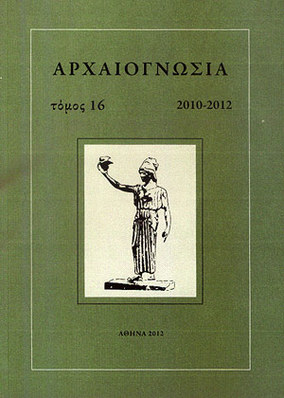Η ταξινόμηση των στάσεων στην αρχαία ρητορική και η σχέση της με την Πλατωνική-Αριστοτελική διαλεκτική
Part of : Αρχαιογνωσία ; Vol.12, No.1-2, 2003, pages 55-90
Issue:
Pages:
55-90
Parallel Title:
the classification of staces in ancient rhetoric and its relationship to Platonic-Aristotelian dialectic
Section Title:
Μελέτες-Articles
Author:
Abstract:
The conflict between Plato’s Academy and Isocrates’ school concering the proper education of free citizens is very well-known. What remains less evident is the influence that the Platonic tradition exerted on the development of rhetorical theory in the Hellenistic and Imperial Age. The paper aims to explore just one aspect of such a positive influence of classical philosophy on post-classical rhetoric.After indicating the dependence (terminological and taxonomic) of Hermagoras’ stasis-theory on Aristotle’s earlier works on dialectic (such as the Topics and the Sophistical Refutations) the paper proceeds to give an exposition of Plato’s method of division (dihaeresis), which is explicity stated to be the culmination of dialectic, in dialogues such as the Republic, the Phaedrus and the Sophist. What is especially noteworthy in Plato’s method is that it always proceeds with bifurcation (or division sensu stricto) and excludes any other (triple, quadruple etc.) possible classification. Aristotle denied the demonstrative character of Platonic dialectic, in general, and of division, in particular, but fully accepted the educational value of the former and the taxonomic value of the latter. Aristotle, contrary to Plato, thought that rhetoric, though not a science in the strict sense, can still be an organized body of experience (rather than of knowledge) concerning issues and questions common to all people. He believed that rhetoric is in a long speech, what dialectic is in a conversation. What is more, Aristotle explicitly stated that a dialectical question is one that can be answered with a “yes” or “no”. This is in fact the implicit principle that accounts for, and justifies, Platonic division to the detriment of other classification schemes. Such a principle can be said to be the common denominator of dialectic in the Platonic-Aristotelian tradition.Now, if we turn to the most developed system of stases as it is exhibited in Hermogene’s genuine work On Stases that further expounds Hermagoras’ theory, we shall be surprised to find out that the entire classification is based precisely on such a principle. Hermogenes’ system proceeds with successive bifurcation, and the two exceptions to that rule can be shown to be no exceptions at all. In all cases, an implicit question answerable with a “yes” or “no” is presupposed. This shows that Hermogenes’ classification indirectly draws on the Platonic-Aristotelian tradition.There is, however, an important difference between Plato’s division and Hermogenes’ classification. Whereas Plato is interested in defining one particular species —which means that the entire enterprise stands or falls depending on whether or not the right-hand of the last division is the required one—, Hermogenes is interested in the left-hand side of all successive divisions that provide his fourteen stases. In other words, whereas Plato, in the process of reaching the final stage, leaves behind the results of preceding divisions, Hermogenes pays due attention to, and employs, in his final taxonomy, the results of all divisions. This means that it is the taxonomic, rather than the demonstrative, aspect of division that is employed of in the Hellenistic and Imperial Age, in accordance with Aristotle’s earlier claim. In this sense, post-classical rhetoric can be said to owe its systematic organization to insights provided by the Platonic-Aristotelian tradition. The precise details of such an influence cannot be recovered, but it might be safe to assume that the first serious encounter of philosophy with rhetoric influenced not only philosophy (as is evident in Aristotle, Theophrastus, Stoicism and many a late-antique Platonic commentator), but rhetorical theory as well.
Subject:
Subject (LC):
Keywords:
αρχαία ρητορική, κλασικές γλώσσες, ελληνική γλώσσα
Notes:
Περιέχει σχεδιαγράμματα




